#Frieze New York
Explore tagged Tumblr posts
Text

ELIZABETH MCINTOSH
Geraniums, 2023
Oil on linen
66" x 51" (167.64 cm x 129.54 cm)
3 notes
·
View notes
Text
Art| FVCKRENDER Unveils New Solo Exhibit "Ascend" at Frieze New York
For Frieze New York, contemporary artist FVCKRENDER heads to the big apple to debut his solo art show dubbed “Ascend” hosted by pop culture critic Carlo McCormick. Ascend contributes significantly to forging forward into a new era of art and artists. The exhibit is a collection dedicated to the meshing of physical and digital artworks which are intended to make a statement for independence &…

View On WordPress
#Art#Art Show#Ascend#Carlo McCormick#Design#Digital Art#DS & Durga#Exhibition#Fine Art#Frieze New York#FVCKRENDER#LISA#Render
0 notes
Photo
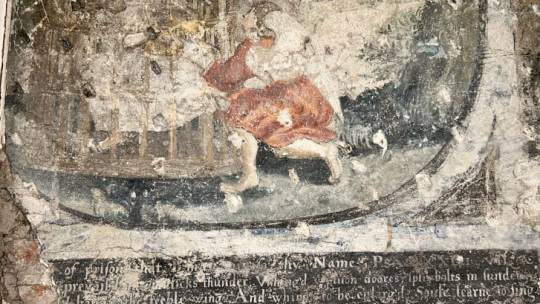

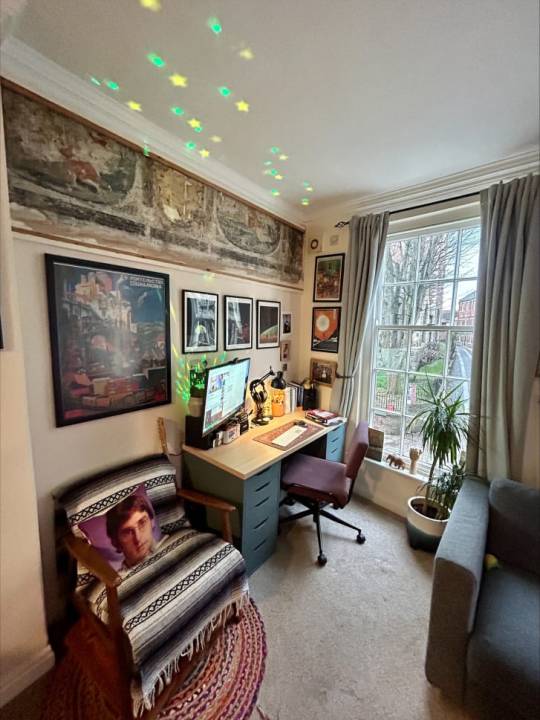
Kitchen Renovation Unearths Paintings Nearly 400 Years Old in York
Murals believed to be nearly 400 years old have been discovered at an apartment in northern England following a kitchen renovation.
Luke Budworth, 29, his partner Hazel Mooney, 26, and their dog Leonard had temporarily moved out of the one-bedroom apartment in the cathedral city of York while their new kitchen was being fitted in December.
Then Budworth received a call from the contractors. He said Monday: "In a very casual way they said, 'did you know there's a painting behind here?'"
By the time Budworth went to take a look, the new kitchen cupboards were on the wall, covering the frieze -- the only evidence of the discovery was a blurry picture taken by the fitters.
Though disappointed, Budworth, a research data analyst at the University of Leeds, suspected that a similar "bit of paneling" on the other side of the open plan living area may be hiding something too.
"It was painted the same as the rest of the wall and I knew it was hollow," he said. "I always thought it was probably just covering some pipes." His suspicion proved correct. "It was a matching piece," he said.
According to Budworth, both friezes measure about 9 feet by 4 feet -- though they are cut off at the top by the ceiling.
The old city of York is encircled by an ancient wall and Budworth's apartment, which he bought in October 2020, lies within that in Micklegate -- one of the city's main streets. The apartment, which sits above a cafe and a charity book shop, is part of a Grade II listed Georgian building dating back to 1747.
"We thought maybe it was Victorian wallpaper, but it was way, way beyond how old I thought it was initially," said Budworth.
The newly exposed frieze depicts a Biblical scene in which a man in a cage is pulled along by an angel. There is also a man in a white cart who, according to Budworth, "looks like he's riding to the kingdom of heaven."
"Really excited," Budworth contacted Historic England, a public body that looks after the country's historic environment. A representative was then sent to survey the artwork and take some detailed professional photographs.
Historic England gave the couple a high quality, life size replica of the frieze and advised them to cover it up in order to preserve it.
Undertaking some historic detective work, Budworth went online and found that both friezes featured scenes from a 1635 book called "Emblems," written by poet Francis Quarles.
"The wall paintings pre-date the flat itself," said Budworth, explaining that the artwork was carried out on a wall of a building that no longer exists. In other words, the building was constructed around an existing wall.
The paintings are believed to have been created between 1635, when "Emblems" was written, and 1700 when such artwork fell out of fashion, Historic England has advised the couple, according to Budworth.
'Fascinating' find
Though the couple do not have the resources to invest in professional conservation of the exposed frieze, they have been keen to incorporate it in their decor.
Budworth said: "If we could find some sort of funding to help conserve it I would be willing to go to the extent of taking the [kitchen] cupboards off the wall but unfortunately I don't see that happening. The other one though will be preserved as best we can."
Historic England confirmed that it had visited the property and had now passed on images of the paintings to the Conservation of Wall Painting department at the Courtauld Institute of Art in London.
A spokeswoman for Historic England said: "The discovery of these 17th century murals in a home in Micklegate, York is fascinating. They were first discovered in 1998 then covered over. We have been involved with documenting the murals and supporting the present owner with how best to look after them since they were rediscovered recently.
"They raise various questions about the ages of the buildings in this row of historic homes and the history of Micklegate itself. Finds like this tell us that our historic homes have many secrets and we've been pleased to work with this homeowner on looking after these murals for the future."
By Lianne Kolirin.
#Kitchen Renovation Unearths Paintings Nearly 400 Years Old in York#frieze#painting#ancient paintings#ancient art#ancient artifacts#history#history news#art#artist#art work#art world#art news#long reads
22 notes
·
View notes
Text
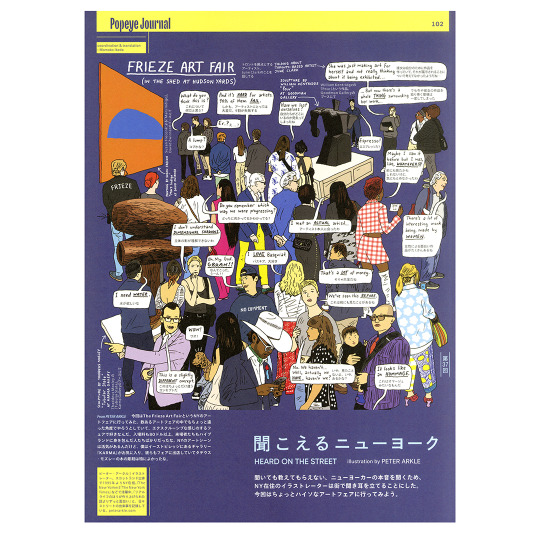
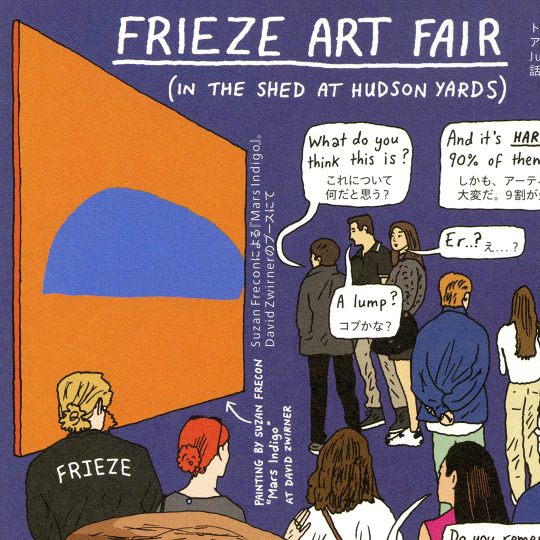
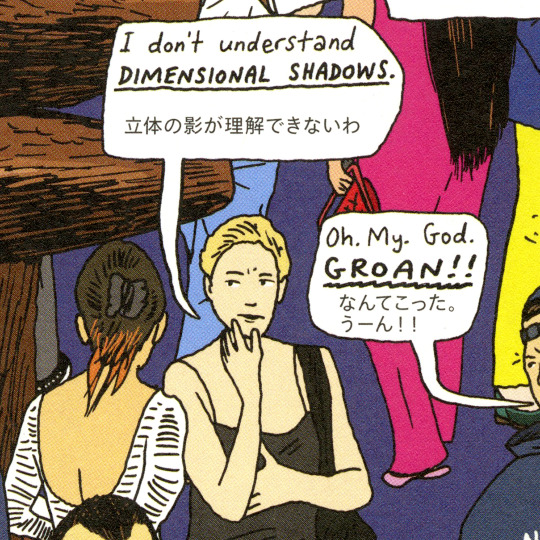

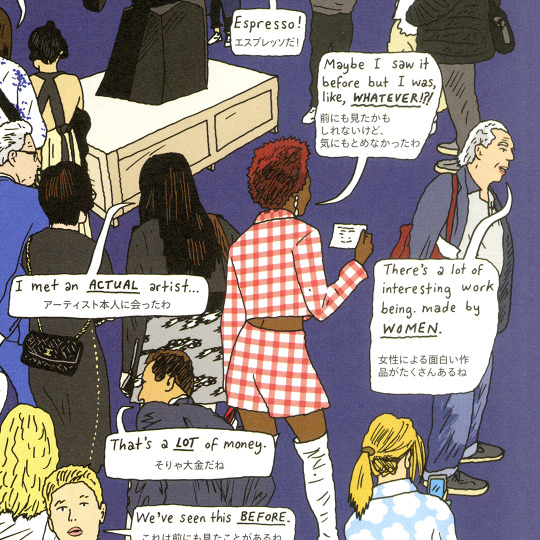
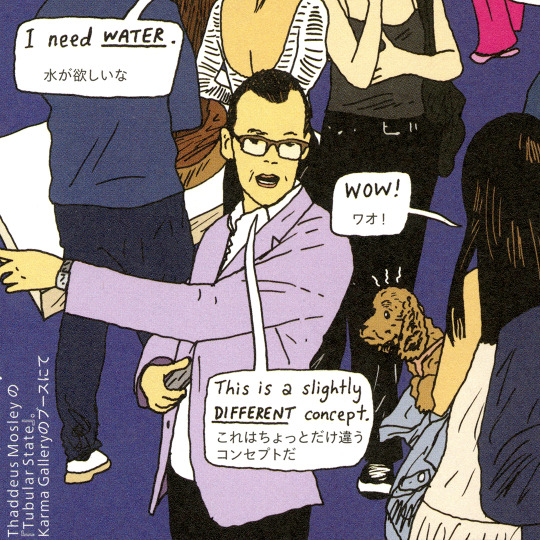
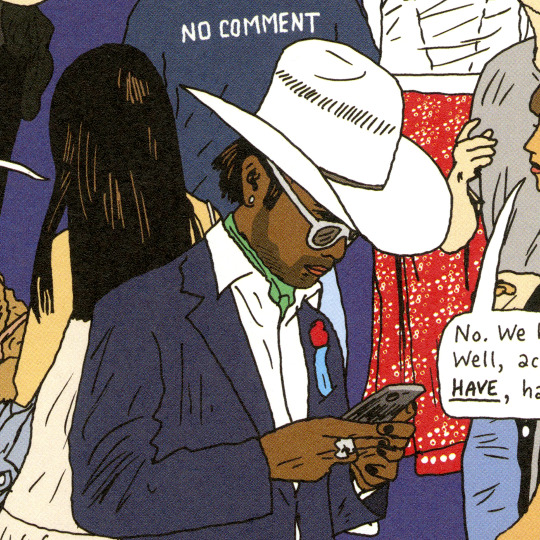
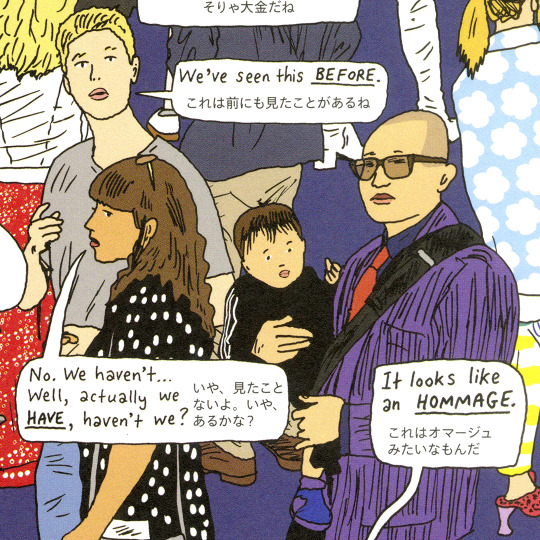
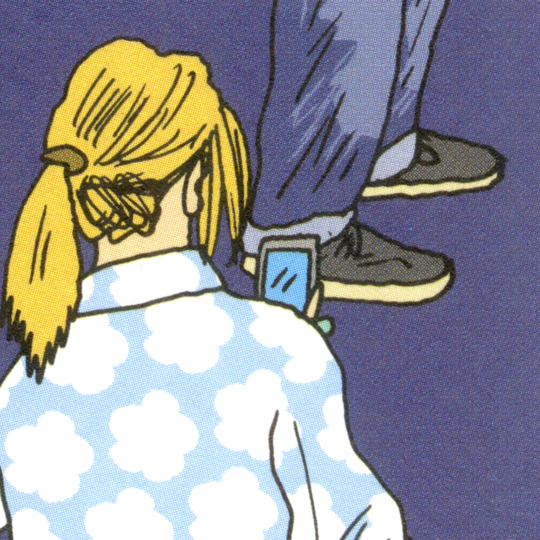
© Peter Arkle 2023 FRIEZE ART FAIR (for Popeye magazine)
#peterarkle#illustration#drawings#notes#nyc#popeye magazine#Peter Arkle#Frieze Art Fair#New York#2023#overheard
6 notes
·
View notes
Text
Everyone is pretty familiar with the difference between a gallery and a museum, but where do art fairs fit in? With everyone in Miami (at the time of recording) Erika and Alexis decided to break it down - what is an art fair? Who goes? Who participates? And why are people flying all over the world and spending quite a bit of money to do it?
#Art Fairs#Art Basel#Basel Miami#Frieze Art Fair#TEFAF#Armory New York#Art world#Art questions#Spotify
2 notes
·
View notes
Text
youtube
From May 1 to 5
Discover more: https://www.frieze.com/article/frieze...
youtube
youtube
0 notes
Photo

The Yellow Cow (1911)
By Franz Marc
Franz Marc’s The Yellow Cow, a color the artist associated with femininity and sensuality, is an expressionist take on animals in art. A remarkable aspect of the painting is the stark contrast between the dynamic subject and the background, which looks calmer, almost still. It’s located at the Guggenheim, New York.

Donkey Frieze (1911)
Part of a private collection, Franz Marc uses Donkey Frieze to represent the deleterious tiredness and fatigue caused by a life of hard work. The concept is highlighted by the color blue, often associated with sadness, and the weary expressions on the donkeys’ faces, perfectly catching the emotion of exhaustion even if the subjects are non-human.
#franz marc#artist#art#painting#painter#the yellow cow (1911)#animal art#expressionist#guggenheim museum#new york#donkey frieze (1911)
1 note
·
View note
Text

Chrysler Building: A Shimmering Icon of Art Deco Elegance
In the heart of Manhattan's bustling skyline, one architectural masterpiece stands tall, capturing the imagination of all who gaze upon it. The Chrysler Building, a shimmering beacon of Art Deco elegance, is not just a skyscraper but a symbol of New York City's enduring spirit and architectural innovation. With its captivating history, exquisite design, and a touch of old-world glamour, the Chrysler Building continues to enchant and captivate, leaving an indelible mark on the Big Apple's iconic skyline.
The Chrysler Building, completed in 1930, was the brainchild of architect William Van Alen. Its distinctive design is a symphony of style, blending Art Deco with influences from the Machine Age. The tower rises to a staggering 1,046 feet, making it one of the tallest buildings in the world at the time of its completion. Its crowning glory, the iconic stainless steel spire, reaches even higher, ultimately soaring to 1,476 feet. This bold architectural choice, combined with the building's tiered setbacks and intricate ornamentation, immediately sets it apart from its contemporaries.
The Chrysler Building's spire is nothing short of a masterpiece. Composed of seven concentric stainless steel arches, it seems to ascend endlessly into the sky, a testament to human ambition and ingenuity. The polished metal glimmers and reflects the ever-changing hues of the New York City skyline, giving the building a dynamic and ethereal quality. The spire's tip is adorned with a spectacular sunburst design, a symbol of hope and optimism that encapsulated the spirit of the Roaring Twenties.
Beneath the shimmering façade, the Chrysler Building holds a treasure trove of architectural marvels. The lobby, in particular, is a breathtaking work of art. A soaring, marble-clad space is adorned with ornate, artful details, including intricate friezes, Egyptian-inspired motifs, and a magnificent ceiling mural by artist Edward Trumbull. The lobby's elegance and opulence transport visitors to a bygone era of sophistication and glamour.
The Chrysler Building's enduring legacy goes beyond its architectural significance. It has played a prominent role in popular culture, making appearances in numerous films, television shows, and works of literature. Its silhouette, unmistakable and timeless, is a symbol of New York City itself, representing both the city's storied past and its ever-evolving future.
Yet, beneath its polished surface and captivating design, the Chrysler Building harbors an air of myth and mystery that adds to its allure. One enduring legend is the tale of a secret spire race between the Chrysler Building and the Bank of Manhattan Trust Building (now known as 40 Wall Street), a nearby skyscraper under construction at the same time. This tale, though perhaps more myth than fact, only deepens the intrigue surrounding this architectural wonder.
The construction of the Chrysler Building was not without its challenges. The architects and builders had to contend with the limitations of 1920s technology, including the absence of modern safety measures and equipment. Nevertheless, the determination and expertise of the builders triumphed over adversity, resulting in an enduring symbol of human achievement.
As we look ahead to the future, the Chrysler Building continues to stand as a symbol of resilience and creativity. While no longer the tallest building in New York City, its timeless elegance and iconic spire remain a source of inspiration for architects, artists, and dreamers alike. Recent renovations and preservation efforts ensure that this shimmering gem will continue to grace the Manhattan skyline for generations to come.
For those who wish to experience the magic of the Chrysler Building firsthand, tours are available to explore its exquisite lobby and learn more about its history and architectural significance. Standing in the shadow of its gleaming spire, visitors can connect with the past, marvel at its beauty, and imagine the countless stories that have unfolded within its walls.
In a city that is constantly changing and reinventing itself, the Chrysler Building remains a steadfast symbol of New York City's enduring spirit, artistic excellence, and architectural innovation. Its shimmering spire reaches for the heavens, while its hidden treasures and legendary history capture the hearts and minds of all who encounter it. As an icon of Art Deco elegance, the Chrysler Building is not just a skyscraper; it's a living testament to the dreams and aspirations of a city that continues to inspire the world. It's a reminder that in the ever-evolving urban jungle of Manhattan, the Chrysler Building's brilliance still shines as brightly as ever, inviting all to partake in its timeless allure.
Chrysler Building - Next page>
#Chrysler Building#new york city#new york#new-york#newyork#urban#nyc#ny#manhattan#city#usa#United States#buildings#travel#journey#outdoors#street#architecture#visit-new-york.tumblr.com
475 notes
·
View notes
Text

3
★ Benedict and Sophie attended the 7th Annual Leaders on Purpose CEO Summit in New York. (post) (more pics)
★ Video with Benedict during the Climate Week in New York City.
9
★ Benedict attended the 2024 Frieze Art Fair VIP preview in London.

11
★ He hosted an special screening for the movie Conclave, directed by Edward Berger.

14
★ President Benedict Cumberbatch attended the 2024 LAMDA Graduation Ceremony.

15
★ Clip from behind the scenes of The Book of Clarence with Benedict as Benjamin, the beggar.
17
★ Producer Benedict Cumberbatch was present at the We Live In Time headline gala for the 68th BFI London Film Festival. (clip) (my post)

25
★ New pics from an old photoshoot surfaced.
30
★ Benedict has been confirmed to attend Tokyo Comic Con 2024.
✧ ── ⋅ FIN ⋅ ── ✧
#benedict cumberbatch#benedict monthly#october 2024#sophie hunter#nyc climate week 2024#conclave screening#we live in time premiere#the book of clarence#tokio comoic con 2024
32 notes
·
View notes
Text

The Death of Socrates (1787) 🎨 Jacques Louis David 🏛️ The Metropolitan Museum of Art 📍 New York City, United States
In this landmark of neoclassical painting from just before the French Revolution, David took up a classical story of resisting unjust authority in a sparse, frieze-like composition. The Greek philosopher Socrates (469–399 BCE) was convicted of impiety by the Athenian courts; rather than renounce his beliefs, he died willingly, expounding on the immortality of the soul before drinking poisonous hemlock. Through a network of gestures and expressions, David’s figures act out the last moments of Socrates’s life. He is about to grasp the cup of hemlock, offered by a disciple who cannot bear to witness the event. David consulted antiquarian scholars to create an archeologically exacting image, including details of furniture and clothing. His inclusion of Plato at the foot of the bed, however, deliberately references not someone present at Socrates’s death but rather the author whose text, Phaedo, preserved this ancient story.
#The Death of Socrates#1787#Jacques Louis David#The Metropolitan Museum of Art#The Met#New York City#United States#french#painting#oil painting#oil on canvas#Neoclassicism#Academic art#La Mort de Socrate#art#artwork#art history
27 notes
·
View notes
Note
Loringrandolphny has a story with possibly Cait. Looks like her hair. She might be wearing a jacket. And you are right no 🧛
Dear Jacket Anon,
You mean this, I suppose?
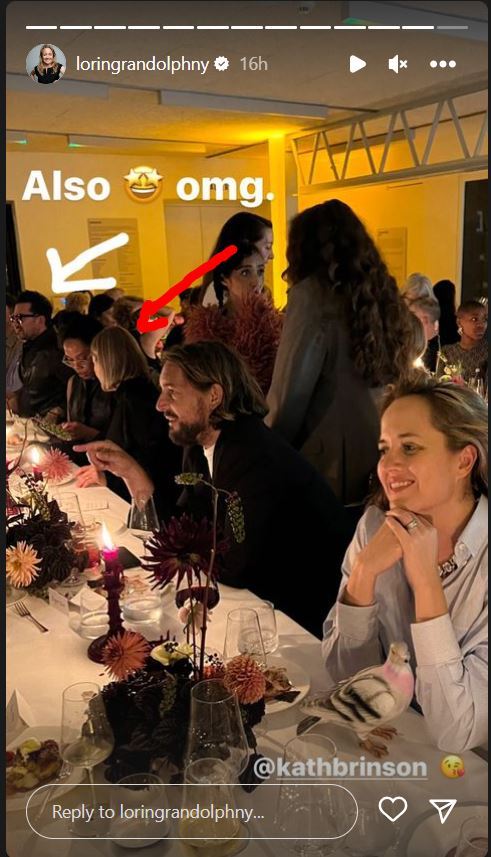
If so, my red arrow could very well point to C. I think it's her, too and the jacket makes sense, for many reasons.
I also noticed Mrs. Randolph tagged Levy, who (we now know) escorted C at the event. So maybe they were introduced to each other, even if they do not mutually follow on Insta (but Randolph also has a secondary private account and so, all bets are possible).
Who is this poster, though? A very sophisticated American contemporary art expert and curator - one of the top 10 in the world, judging by her credentials (Frieze is probably the world's leading contemporary art magazine and resource portal, to which I would add Sotheby's) :


Currently, she manages the Nasher-Haemisegger Collection, based in Dallas, TX, but she's doing it from Brooklyn, which tells me a lot (irreplaceable expertise):
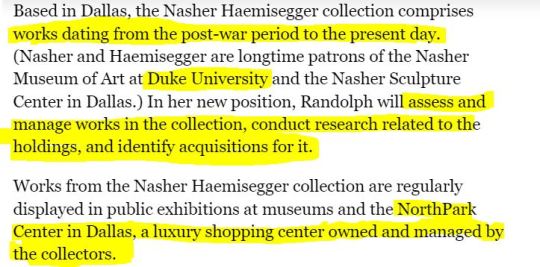
(sourced at: https://www.artnews.com/art-news/news/loring-randolph-frieze-new-york-director-steps-down-1202697196/)
Enough said. The facts that Mrs. Randolph also follows Dua Lipa (behave!), reads The New Yorker (so does this humble blogger) and is interested in getting the planet's oceans rid of plastic are not enough for me to infer anything. These can at most sketch a profile, placing her into the well-heeled and Democrat New-Yorker crowd, bikram yoga on top. Nothing less, but nothing more.
I would like to add something. There are no 'more' and 'less' important events when it comes to these two people networking at the same damn time (isn't that uncanny?). There are different events, attracting different crowds, with different purposes. You would, however, have to be very parochial or quite idiot not to think worlds collide very easily at that level of wealth and rolodex power. And the more you climb up the social scale, the less degrees of separation it takes to connect the dots. In other words: most, if not all of the people present at the Keepers event or the Loewe Foundation one (or the Harrod's, FWIW) know or at least heard about each other. You'd be surprised.
Last, but not least, I am going to ask a very cruel and reactionary question: how do you think Tracula would fit in such company?
I'll mercifully leave this unanswered. But I hope my long rant satisfied at least your curiosity, Anon.
104 notes
·
View notes
Text

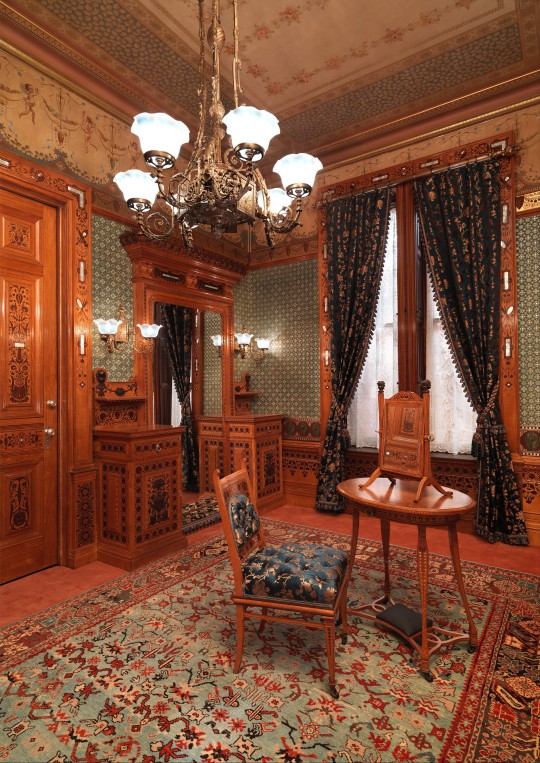
Side Chair from the Worsham-Rockefeller Dressing Room
1881-1882
George A. Schastey & Co.
In 1881, Arabella Worsham, then-mistress of railroad magnate Collis P. Huntington, hired George A. Schastey & Co. to decorate her townhouse at 4 West Fifty-Fourth Street in New York City. The resulting artistic interiors would have been considered the height of cosmopolitan style in the early 1880s and were emblematic of Worsham’s quest to fashion her identity as a wealthy, prominent woman of taste. When Worsham married Huntington in 1884, she sold the house, fully furnished, to John D. and Laura Spelman Rockefeller, who made few subsequent changes to the decorations. Following Mr. Rockefeller’s death, the house was demolished in 1938, yet some furnishings, large-scale architectural elements, and three interiors were preserved, and the rooms were donated to local museums by John D. Rockefeller Jr.
This side chair of satinwood and purpleheart, one of a pair, is part of the suite (2009.226.1–.4) that furnished Worsham’s elaborately decorated dressing room, one of the preserved interiors now installed in The American Wing (Gallery 742). These objects were part of a decorative program that encompassed every aspect of the room, including the architectural woodwork, lighting, stenciled wall-treatment, painted ceiling and frieze, textiles, and other furnishings. On the chair’s back, the marquetry decoration of grotesque masks and vines echoes the ornamental motifs in the dressing room’s architectural woodwork. The overall form is light and rectilinear. The tapered front legs with cascading bellflowers channel the spirit of English Neoclassical designers such as Robert Adam and George Hepplewhite. It rests on castors, allowing it to be moved easily within the room.
Although few objects can be attributed to George A. Schastey & Co., the high quality of their work – as seen in this fine example – was comparable to other prominent firms of the Gilded Age, including Herter Brothers and Pottier & Stymus. At its peak in the early 1880s, the firm employed at least 125 people in its workshops. Their distinctive designs are steeped in Renaissance sources with flourishes from the Islamic world and the British design reform movement.
The MET (Accession Number: 2009.226.3)
#side chair#furniture#furnishings#1880s#gilded age#19th century#rockefeller#huntington#1881#1882#antique furniture#united states#the met
217 notes
·
View notes
Text

Oh yeah also here's a screenshot of my other in-the-works project that I haven't had a lot of time to work on in the middle of trying to crowdfund our fucking groceries and survive capitalism.
If you want to help support this project, pledge to my Patreon.
I haven't posted many updates so far in 2023, but that's directly because of the aforementioned "I'm really exhausted trying to survive capitalism." Did I mention how tired I am of begging for grocery money on tumblr? Because I'm pretty tired of having to beg for grocery money on tumblr.
Image transcript below:
A History of Queer American Animation
by Ren Basel
Thesis
The late 2010s saw a turning point in queer representation in animation, with the production of shows such as Steven Universe and She-Ra & the Princesses of Power—but they weren’t the first cartoons to show queer characters. Queerness has a long history in American animated media, stretching back to the very foundations of the medium.
Notes
Before Mickey: The Animated Film 1898-1928, by Donald Crafton
Cinema had already gained a reputation as “highbrow” and “intellectual” by the 1920s.
From its origins, animation was regarded as a “minor branch” of cinema. In the silent film period, animation was considered commercially insignificant by distributors and scholars.
Steamboat Willie premiered at the Colony Theater in New York on November 18, 1928, and was the animated equivalent to the live-action film “The Jazz Singer,” bringing together moving pictures and synchronized sound.
The cinema came into existence in 1895. The specific origins of animation, however, are hazy, with the first commercial animation appearing in 1898, but no clear record of when animation technology really “began.”
Precursors of modern animation include historical sequential art such as hieroglyphic friezes, Chinese scrolls, and the Bayeux Tapestry. Other examples of proto-animation include magic lanterns, the Fantascope, slide projections, shadow plays, and other optical tricks and curiosities.
Emile Reynaud (1844-1918), often called “the father of the animated cartoon,” was a teacher of math and science. He created the praxinoscope, a gadget that used revolving mirrors to reflect drawings, which the viewer could see without looking through slits as in prior moving-picture devices. In 1879, Reynaud refined the tabletop “praxinoscope theater,” and further developed the device into an audience theater in 1892, called the Theatre Optique in Paris.
Many animation pioneers were inspired by flipbooks.
221 notes
·
View notes
Text

NYC 1989
I returned to New York City in 1989 and almost immediately found a job for myself there, photographing the artwork for a record my friend Jane Bunnett had recorded with jazz pianist Don Pullen. (My first record cover, I think.) I had tentatively tried my hand at street photography when I visited the city for the first time, four years earlier, but this job turned out to be a shakedown cruise for the Rolleiflex I'd recently purchased - a camera that would be basically my main portrait camera for the following decade. My then-girlfriend had just moved to the city for college so I had a place to stay, and I set out every day with a brief to collect photos that evoked NYC for the package of Jane's CD, which would be called New York Duets.



Over two trips to New York City in late summer and fall of 1989 I busied myself with taking shots of the city for my friend Jane's CD artwork, wandering through the Village where I was staying, north to Rockefeller Center and south to Wall Street, trying to find evocative shots that said "Manhattan!" without hitting the old cliches too hard. Those old cliches were hard to avoid in any case; I stayed away from Central Park, the Empire State and Chrysler buildings and the Statue of Liberty, but I still couldn't avoid other, just as obvious shots - the art deco friezes at Rockefeller Centre, fire escapes, graffiti, the Stock Exchange and the twin towers at the World Trade Center - the only photos I ever took of those iconic and tragically long-gone buildings, at sunset down at the end of West Broadway.





My New York City photos for my friend Jane Bunnett's record ended up doing the job: a shot from Rockefeller Center ended up on the cover, a few more made it on the inside and back cover of the booklet, and along the way I ended up with some photos I still like today. One shot in particular, of a group of men playing cards at the chess tables in Washington Square Park, has become a historical document; you don't see men dressed this way today, or faces like this. Most of the men in the photo are probably dead by now. I still find myself trying to take quintessential photos whenever I'm back in NYC today, but I'm old enough now that I don't care if I aim squarely for those iconic postcard shots, mostly because on the way between taking them you might find yourself finding something less obvious.





#rolleiflex#black and white#film photography#some old pictures i took#new york city#manhattan#world trade center#1989#jane bunnett#album cover#early work#rockefeller center
7 notes
·
View notes
Photo
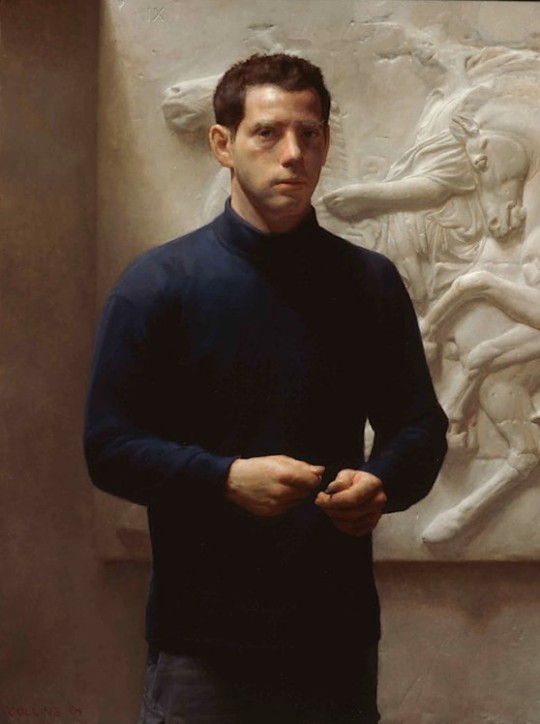
Jacob Collins - Self-Portrait with Parthenon Frieze
Jacob Collins (born 1964) is an American realist painter working in New York City. He is a leading figure of the contemporary classical art revival.
139 notes
·
View notes
